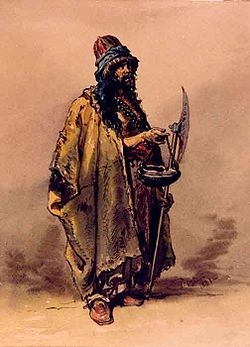Dervish: Difference between revisions
m Reverted 2 edits by FredericThormann. using TW |
No edit summary |
||
| Line 22: | Line 22: | ||
==Historical and political use== |
==Historical and political use== |
||
Various western historical writers have sometimes used the term ''dervish'' rather loosely, linking it to, among other things, the [[Muhammad Ahmad|Mahdist uprising]] in [[Sudan]] and other rebellions against [[colonialism|colonial]] powers. |
Various western historical writers have sometimes used the term ''dervish'' rather loosely, linking it to, among other things, the [[Muhammad Ahmad|Mahdist uprising]] in [[Sudan]] and other rebellions against [[colonialism|colonial]] powers. |
||
== External links == |
|||
* [http://www.whirlingdervishes.ca The Whirling Dervishes of Rumi Canadian Tour] |
|||
* [http://www.sufidervish.org Rifai Dervishes] |
|||
* [http://www.dervish-yoga.com Dervish Yoga] |
|||
{{commonscat|dervishes}} |
{{commonscat|dervishes}} |
||
Revision as of 09:03, 6 October 2007


The word Dervish, especially in European languages, refers to members of Sufi Muslim ascetic religious Tarika, known for their extreme poverty and austerity, similar to mendicant friars.
The term comes from the Persian word Darwīsh [1] (درویش), which usually refers to a mendicant ascetic. This latter word is also used to refer to an unflappable or ascetic temperament (as in the Urdu phrase darwaishana thabiyath for an ascetic temperament); that is, for an attitude that is indifferent to material possessions and the like.
As Sufi practitioners, dervishes were known as a source of wisdom, medicine, poetry, enlightenment, and witticisms. For example, Mollah Nasr-ad-Din (Mulla Nasrudin, Hoja Nasrudin) had become a legend in the Near East and the Indian subcontinent, not only among the Muslims.
Religious practice
Many dervishes are mendicant ascetics who have taken the vow of poverty, unlike mullahs. The main reason why they beg is to learn humility, but dervishes are prohibited to beg for their own good. They have to give the collected money to other poor people. Others work in common professions; Egyptian Qadiriyya – known in Turkey as Kadiri – for example, are fishermen. Rifa'iyyah dervishes travelled and spread into North and East Africa, Turkey, the Balkans and all the way down to India.
There are also various dervish groups (Sufi orders), almost all of which trace their origins from various Muslim saints and teachers, especially Ali and Abu Bakr. Various orders and suborders have appeared and disappeared over the centuries.

Mevlâna mausoleum, Konya, Turkey
The whirling dance that is proverbially associated with dervishes, is the practice of the Mevlevi Order in Turkey, and is just one of the physical methods used to try to reach religious ecstasy (majdhb, fana). The name "Mevlevi" comes from the Persian poet, Rumi, whose shrine is in Turkey and who was a Dervish himself. This practice, though not intended as entertainment, has become a tourist attraction in Turkey.
Other groups include the Bektashis, connected to the janissaries, and Senussi, who are rather orthodox in their beliefs. Other fraternities and subgroups chant verses of the Qur'an, play drums or dance vigorously in groups, all according to their specific traditions. Some practice quiet meditation, as is the case with most of the Sufi orders in South Asia, many of whom owe allegiance to, or were influenced by, the Chishti order. Each fraternity uses its own garb and methods of acceptance and initiation, some of them which may be rather severe.
Historical and political use
Various western historical writers have sometimes used the term dervish rather loosely, linking it to, among other things, the Mahdist uprising in Sudan and other rebellions against colonial powers.
